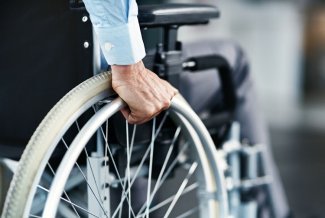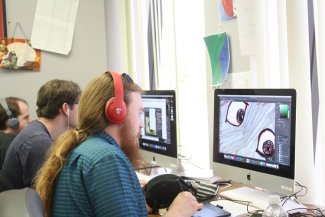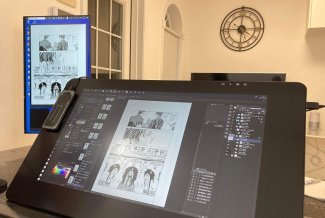Gert Jan, a paraplegic patient at the Lausanne University Hospital, performs walking tests with the help of a brain-spinal cord interface developed by researchers, Lausanne, Switzerland.
Artificial intelligence continues to develop at a breakneck pace, transforming one industry after another. One area where AI has already proven successful is in improving the day-to-day lives of people with disabilities. Examples include a brain-spinal chord interface that helps people relearn how to walk, AI-enabled voice assistants (such as Olga Phone and Google Assistant) which make it easier for visually impaired people to use their smartphones, learning algorithms that enable computers to understand users’ intentions and anticipate a command, etc.
Around 87 million people in the European Union suffer from some form of disability, which can sometimes result in their exclusion from the workplace or even from society as whole. According to figures published by the European Parliament in June 2020, there is significant room for improvement when it comes to their professional integration: the employment rate for people with disabilities in the EU (ages 20 to 64) stands at 50.8 per cent, compared to 75 per cent for able-bodied people.
Given that access to employment depends first and foremost on access to training, how can disabled people be better helped to learn using AI tools?
Impact AI is a French think tank whose members include companies, start-ups and schools that train future data analysts. Together, they are looking for solutions to create “conditions conducive to human-centred AI”.
The group has carried out research in partnership with the EdTech association to study specific needs (according to the type of disability: hearing, visual, physical, cognitive, etc.) and identify existing technological solutions. These are generally based on powerful algorithms and intelligent software capable of analysing data and generating responses to certain commands. They facilitate, for example, image recognition and analysis, lip-reading, transcription of audio into text (dictation, generation of subtitles), translation into sign language, etc.
One of the projects the group is presenting and supporting is Roger Voice, a “solution combining automatic speech recognition and voice intonation,” designed for the deaf and hard of hearing. Another is ISIcrunch, a software solution that uses artificial intelligence to produce online texts (such as ebooks or epubs) by digitising teaching materials and converting them into accessible formats.
Increasing the availability of digital resources for people with sensory or cognitive impairments represents a major challenge for inclusion and the future of work, and is the subject of an international treaty between the European Union and the World Intellectual Property Organisation.
Professional integration: pitfalls and perspectives
According to Jan Ramon, a researcher at the French National Institute for Research in Digital Science and Technology (INRIA), “integration into working life is better thanks to technology”. Some workers with disabilities are already using automatic transcription and text recognition to help them with their tasks. “I think that AI will help these people [more and more] over the years to come. But it’s early days yet”. In Ramon’s opinion, the latest developments in AI are still primarily aimed at the general public and often fail to target people with disabilities.
Federico Camporesi works for the Association for Research and Training on Integration in Europe (ARFIE) on the problems of integrating disabled workers into the workplace. In his view, “companies and even governments should invest in promoting progress in this area”.
AI technologies for disabled people have seen greater advances in certain business sectors, particularly those that involve work with computers and intellectual, rather than physical, functions.
Voice assistant technology is currently booming. Olivier Gatelmand is the founder of Olga, a voice assistant for smartphones designed for people with reduced autonomy or visual impairments. “We created the service seven years ago. At the time, artificial intelligence was not at all widespread. Every access to our phone is voice-activated. We implemented a system in Olga that enables conversational intelligence to be used to search for information. Users can then learn more easily and receive help in their decision-making. It’s kind of like a voice-activated ChatGPT”.
“[Currently] we are mainly focused on people with visual and motor disabilities. But it’s important to understand that disabled people have different abilities,” says Gatelmand, who has also addressed the possibility of diction problems in users. “We’ve carried out tests with autistic children. Based on a specific case, we learned that artificial intelligence could potentially rephrase words in sentences that are difficult to understand”.
As a visually impaired person, Ramon uses services to help him in his day-to-day life. For example, when interviewed by Equal Times over Zoom, the words he says appear on his screen. It’s a way of getting a better grasp of what’s being said. “This technology still has room to improve”. He predicts that people who are deaf or hard of hearing will be able to obtain a similar application in “about two years.”
However, a number of questions remain unanswered, particularly with regards to the legislative framework for supporting the introduction of new tools. “Society evolves, opportunities evolve, but the problems associated with legislation require a great deal of knowledge,” continues Camporesi. “We need to clarify the issue of data management and privacy”.
The issue of digital privacy rights in relation to technology in the workplace is not specific to disabled workers alone.
Medical advances for greater autonomy in the future
Last August, the media reported that a new research breakthrough at Stanford University in the United States had enabled paralysed people to speak using brainwaves. Artificial intelligence can now transcribe neural signals into text and words. Thanks to a “device consisting of electrodes implanted in the brain,” patients can regain the use of speech with a synthetic voice that is personalised and closely approximates their original voice. While these pioneering trials are promising, there is still a long way to go to develop a technology that is smoother, less invasive and more widely accessible.
Another revolution is underway at the Lausanne University Hospital (CHUV), where Henri Lorach, project leader for the brain-spinal cord interface, has been running a project since 2018, whose aim is to enable people rendered paraplegic by accidents to regain the ability to walk.
“Initial results were published on primates. Researchers demonstrated the intention to walk and stimulate the spinal cord to restore voluntary motor function in the animals,” explains Lorach. “The NeuroRestore laboratory had been working on this subject for ten years. This work makes it possible for various muscles to be reactivated even years after an injury. Through electrical stimulation, we are able to abolish certain muscle responses and control walking. In 2018, an article appeared in the journal Nature”.
Artificial intelligence comes into play a little later in this novel process. “Initially, patterns were pre-programmed to make someone walk again. The second stage was to have an implant in the brain, above the motor cortex, to help the patient carry out the movements. Artificial intelligence then helps us to interpret the signals from the brain and to know which signals are linked to which intentions. We train the algorithm to know when the patient is thinking of bending their leg, extending their knee, etc. Our 64 electrodes record brain activity on the surface,” explains Lorach.
While only one patient is currently benefiting from this programme, “others are waiting. Our aim is to implant around ten people over the next three or four years”.













